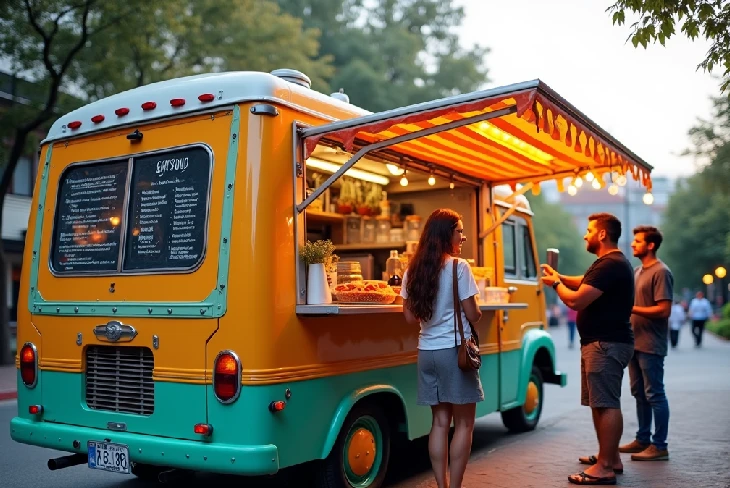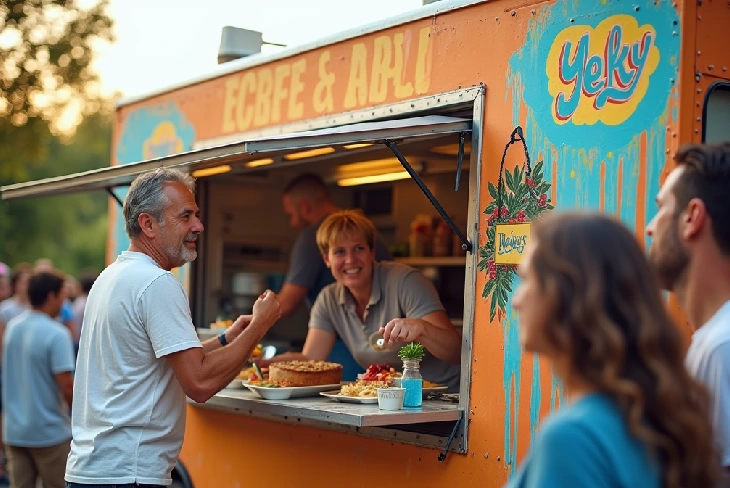Starting a food truck business seems like an exciting venture, but it comes with its own set of challenges. In this article, we will dive deep into various aspects of starting and running a successful food truck business.
We’ll cover topics like menu planning, location selection, regulations, financing, marketing, and more. By following some tried-and-tested tips, you can build a thriving food truck empire of your own. Let’s get started!
Research Thoroughly Before Taking the Plunge
The food truck industry is booming with growing popularity and flexibility. However, it is crucial to do in-depth research before starting your business. Find out about the licenses and permits required in your area. Different cities and states have diverse regulations around mobile food businesses. Study the local food scene – determine which cuisines or menus have gaps that your truck can fill. Consider factors like weather, events, foot traffic etc. when choosing your concept and locations.
Reach out to existing food truck owners for advice. Learning from their experiences will help you avoid common mistakes. Research equipment needs and costs – from kitchen setup to commissary kitchen facilities. Make sure to factor in maintenance, insurance, and replacement costs as well. Create financial projections including startup costs, monthly expenses, and profit margins. Have a well-thought-out business plan in place before investing your time and money. Thorough preparation will set you up for success from day one.
“Research is the backbone of any new business. The more informed you are, the better decisions you can make to create a viable operation.” – Mary Smith, owner of Soup’n Burger food truck.

Choose the Right Menu and Concept
Your menu is the cornerstone that will attract customers and earn profits. Decide on a cuisine or concept that best suits your skills, passion and market needs. Some popular options are ethnic comfort food, healthy alternatives, breakfast items etc. Focus on 2-4 signature items and keep additional choices simple. Complex menus are difficult in a small space.
Opt for foods that can be prepared quickly on the go. Avoid items needing elaborate cooking times or strict holding temperatures. Use seasonal, local ingredients wherever possible. This helps with freshness and sustainability. It is also advisable to offer vegan, vegetarian, gluten-free options to appeal to a wider audience.
Customers are drawn to innovative menu items with intriguing descriptions. Consider creative twists on classics or regional specialties. Use descriptive names and share sample menus on your website and social media to build excitement. Get feedback from friends to refine the choices. With the right concept and carefully picked menu, you are all set to move customers.
Choose Prime Locations for Maximum Footfall
Location is key to the success of a food truck business. Research high traffic areas like office parks, universities, parks, sporting venues etc. Look for spaces with limited food options nearby to gain more patrons. Locations near construction sites or bus stations work well for breakfast and lunch crowds.
Events like concerts, festivals and fairs attract huge footfall. Reach out to organizers for popup opportunities. Schedule regular visits to locations with loyal customer bases so they get used to your presence. Use a mix of daily spots and weekly rotations based on your production capabilities. Geotarget social media posts to promote your whereabouts each day. With the right mix of high footfall locations, you can build a steady customer base.
Table: Sample Weekly Location Schedule | Day | Location | Time Slot | |-|-|-| |Monday| Construction site on 5th Ave| 10am – 2pm| |Tuesday| Business Park on Maple St| 11am – 3pm|
|Wednesday|City Park| 12pm – 4pm| |Thursday| University Campus | 1pm – 5pm| |Friday| Downtown area near offices| 11am – 3pm| |Saturday| Farmers Market| 8am – 1pm| |Sunday| Local park concerts | 4pm – 8pm|
Secure Funding, Permits and Licenses
Mobilizing your dream food truck requires significant capital. Research funding options like bank loans, crowdfunding campaigns and grants. Have thorough financial projections and collateral ready to present a compelling case for loans. Many startup grants are available specifically for women, veterans or minority-owned food businesses too.
Obtain the required permits and licenses for your city or state. These usually include a mobile food vending license, commercial kitchen certification, health department certifications etc. Make sure your equipment adheres to all safety standards. Commercial auto and general liability insurance is essential for operating on public streets.
Choose a certified commissary kitchen for food prep, storage and disposal when your truck is not in service. Some cities require this for proper hygiene. Maintaining the right licensing shows customers and regulators that you run a legitimate and compliant business.
Design and Outfit the Food Truck
With funding secured, focus on transforming your vehicle into a professional mobile kitchen and brand. Choose a sturdy truck suitable for you menu needs. Box trucks work well due to space, but retro food trucks have greater curb appeal.
Design an eye-catching paint job and wraps showcasing your brand identity and cuisine. Include photos of signature items. Well-placed lighting improves night visibility and ambience. A canopy creates cover from rain and sun. Install commercial-grade equipment like grills, fryers, warmers, sinks etc. for safe food handling.
Incorporate eco-friendly features like energy-efficient appliances where possible. Storage for dry goods, refrigeration and freezers is essential based on your menu. Include branding on umbrellas, servers’ uniforms and packaging for a cohesive look. A well-designed truck attracts new customers through innovative visuals and operational efficiency.
Launch Marketing Campaign Before Sales
While research, funding and outfitting are essential preparations; Marketing is key to exposure and sales. Launch social media profiles at least two months before your grand opening. Share your story, photos of the truck build and sneak peeks of the menu. Partner with local influencers for sponsored posts.
Design professionally printed menus, banners and flyers to distribute at prime locations, community hangouts and business centers. Promote an opening day offer or contest on social media like the first 50 customers eat free or win a prize. Boost relevant posts based on your location schedule. QR codes on menus take customers directly to your website or online ordering platform like DoorDash.
Partner with nearby companies for lunch time promotions and contests. Offer coupons or discounts to their employees. Participate in local expos, farmers markets and concerts to meet potential customers face-to-face. With advance planning and consistent promotions, you can generate buzz and book slots on launch day. Nurture repeat visits through excellent customer service.
“We promoted on social media for 2 months and offered discounted combo meals on opening week. It was great exposure and our truck was fully booked for the first month!” – Jen, Co-owner of Gourmet Grub food truck.
Train and Manage Crew for Flawless Operations
A well-oiled team is crucial for smooth on-the-go food service. Screen candidates carefully based on skills, experience and work ethic. Provide new hire training on safety, sanitation, customer service and your specific processes. Cross-train crew members so they can fill in any position as needed.
Schedule staff based on your location and serving hours. Maintain adequate coverage during peak periods. Use management software to streamline scheduling, inventory, orders and payroll. Lead by example with exemplary work ethic. Praise employees openly for good work and address issues privately. Conduct periodic refresher sessions to reinforce best practices as your business evolves. Your team is your biggest asset – keep morale high through appreciation.
Maximize Profits with Steady Supply Chain Management
To maintain consistent quality and minimize downtime, set up reliable suppliers from day one. Choose local produce vendors who understand your needs as a mobile operation. Establish accounts with protein, dairy and dry goods distributors for volume discounts. Maintain backup supplier options to avoid disruption in case a primary partner is unavailable.
Negotiate favorable payment terms where possible by committing to regular orders. Use inventory management software to track consumption and place automated reorder requests. Store ingredients in the right temperatures based on perishability both in the truck and commissary. Proper storage extends shelf life to reduce wastage. With efficient procurement and supplies, you minimize expenses while serving customers smoothly.

Continually Evolve through Customer Feedback
Customer satisfaction should be top priority. Distribute comment cards and encourage online reviews. Respond promptly to address concerns and highlight positive experiences. Track menu statistics to determine popular and slow-selling items. Replace slower choices with test recipes or seasonal specials.
Solicit suggestions through customer surveys or social media polls. Customers appreciate being heard and will feel involved in your growth. Adjust processes based on trends emerging from feedback. For example, adding mobile pay options if standing in long lines is an issue. Celebrate milestones and share success stories to strengthen bonds. Continuous evolution keeps your concept fresh and customer-centric for long-term viability.
Scaling Requires Strategic Location Expansion
Once your first truck stabilizes, evaluate expansion based on consistent profitability and demand. Additional trucks multiply your revenue but require more capital and effort. Research suitable new locations for coverage. Consider gaps near existing slots or emerging hubs.
Apply strategic management techniques to delegate responsibilities as you grow. For example, appointing area managers can supervise daily logistics across trucks. Franchising offers steady income through royalties but requires customized frameworks. The path ahead requires careful planning as success breeds more opportunities. Scale gradually based on solid groundwork and market potential.
In conclusion, starting a food truck business demands time, capital and effort but the rewards are immense if handled professionally. Applying tried-and-tested strategies helps navigate through various challenges smoothly. With the right concept, team, operations and continuous improvement mindset – you are all set to transform your food passion into a thriving on-the-go venture. Best wishes for your culinary journey ahead!